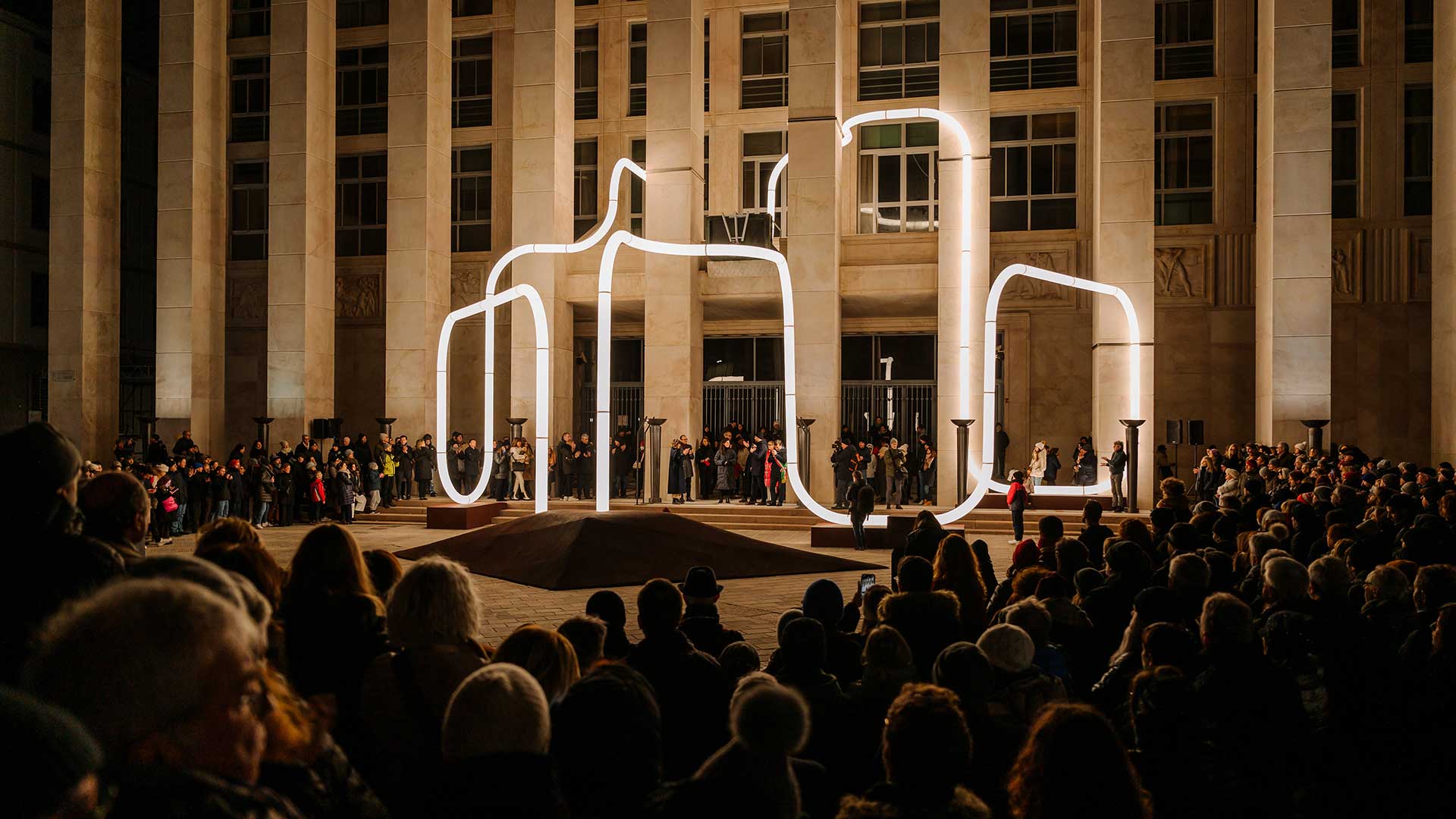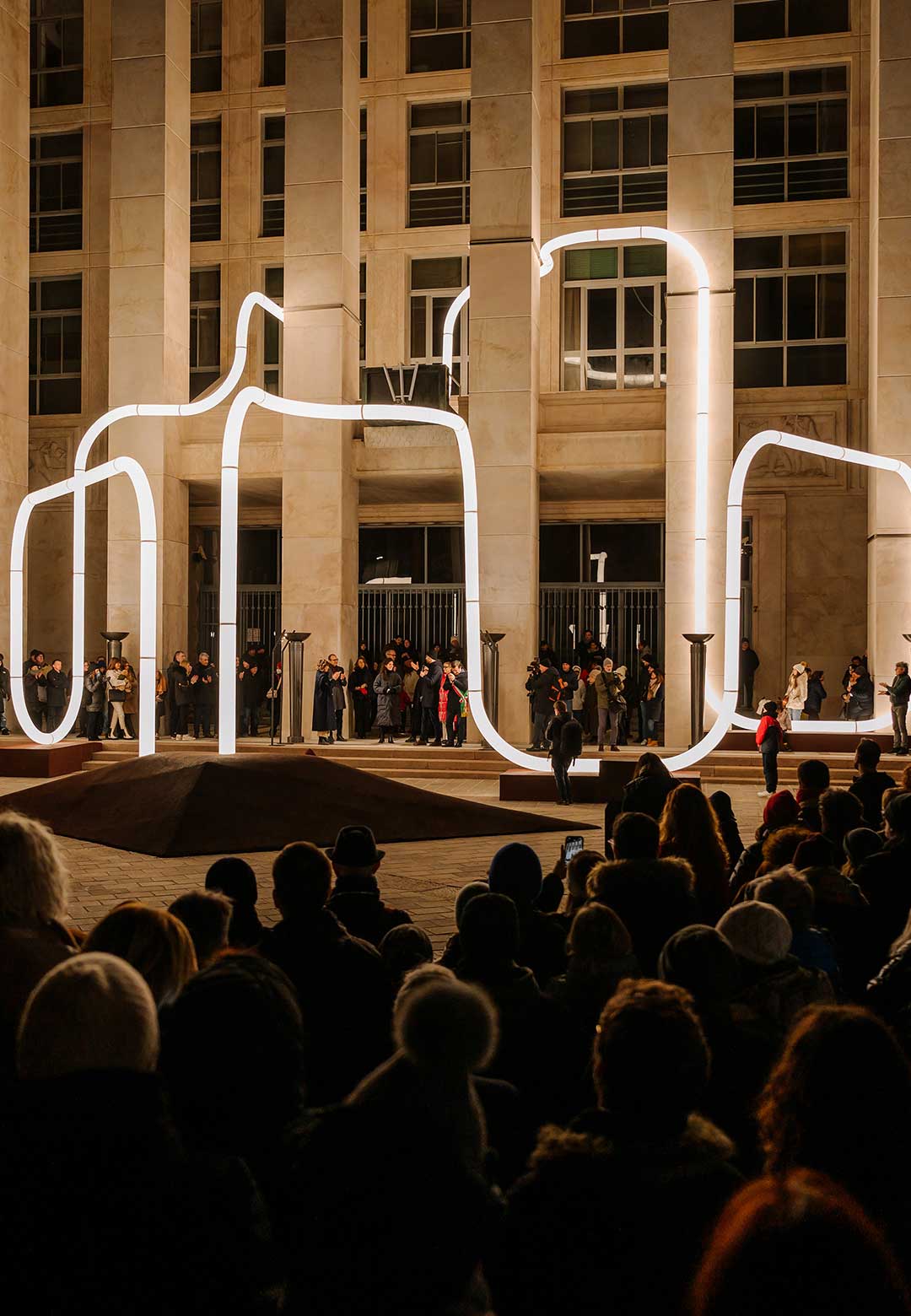What happens when an accessible public square interacts with abstract and sculptural articulations of design?
When Objects of Common Interest, a research and design studio based in New York and Athens led by Eleni Petaloti and Leonidas Trampoukis were tasked with proposing a design intervention as part of the Bergamo - Brescia Italian Capital of Culture 2023 programme, for its ‘Cultural Capital’ (which sees Brescia and Bergamo in Italy take the title of the ‘illuminated city’), the duo chose the medium of a large, site-specific light sculpture that transcended into a stand-alone art piece. Titled ‘Lights On’, their winning proposal is quietly mesmerising and interactive, elevating the built public realm through design, in response to the brief which sought to integrate four key themes— ‘city and nature, hidden treasures, the city that invents, and culture as a cure.’
With softly curving lighting pieces that seem to grow from the ground or advance from the building itself and into the square like illuminated parasites and a playful curation of colourful seating blocks, ‘Lights On’ seems to mutate and travel through Bergamo’s Piazza della Libertà’s hardscape floor at a fancy pace. The public installation invites interaction along the plaza by setting dialogue with the monumental architecture of the collonaded Casa della Libertà, softening its harsh demeanour and enhancing connections with passers-by. The intervention extends the plaza by activating it across scales, renewing an otherwise desolate location by “inserting an element of joyful fun into it,” the Greek designer duo relays. This was accompanied by a stepped platform made of recycled tyres and decorated with jewel-like resins around the square’s fountain, encouraging interaction with it.
“Reactivate, Reuse, and Renew were the principles which drove our proposal, furthering our existing ethos, 'that true change comes from re-appreciating and re-purposing,' which we already possess. All elements have been designed to have an afterlife, either as a whole or in parts—each piece can be reassembled in a variety of clusters at different locations, making them modular at heart,” they continue.
Working between objects, installations and spaces, Objects of Common Interest spoke to STIR at length about their site-specific installation which opened to the public towards the end of January 2023, created in collaboration with GAMeC and supported by Confindustria Bergamo.
Jincy Iype: Why is your site-specific light sculpture named so? Could you tell us what led to its genesis and what it comprises?
Objects of Common Interest (OoCI): It is a three-part installation activating the whole Italian plaza in a variety of ways. The title ‘Lights On’ enjoys a ceremonial aspect, as this commission is a celebration of Bergamo Italian Cultural Capital. We created an intervention in three scales— that of the architectural, with a light tube sculptural installation (a scaled-up version of our ‘Tube’ lights), an array of marble stacked blocks as seating, and a series of solid cast resin stools, lit from below and surrounding the central fountain, thus activating the whole plaza in various, happy ways.
Our light sculpture aimed to reactivate what is currently an underused public space and transform it into an entirely new landscape, that of an ‘illuminated city’ bringing the plaza back to life and introducing a human scale to it once more. Passers-by are drawn in and invited to watch the light sculpture transform as the sun goes down, illuminating the plaza within its glow.
Stackable, movable, seatings which have been carved out of leftover marble blocks from local quarries create seating in a subtle dialogue with the space. The new recycled tyre hardscape floor was designed to complement and play with the existing central fountain, creating a hill up to it, transforming both the mundane, forgotten objects of a built realm and its spaces into something playful and intriguing. This intervention is meant to uplift and reactivate this public space and give its citizens somewhere to sit and gather all day long, allowing it to become part of their everyday lives once more.
The main piece is the sculptural light, articulated as a three-dimensional network of tubular lights that blend with the architectural scale of the building. It is raised many metres above the ground and into the plaza, inviting passersby to stand below, look up, walk around, and sit down, while its careful glow can be seen from afar, from all the small side streets, and from those approaching the plaza from different directions.
Often in our work, a concept directs the material selection due to its properties and possibilities. The rigid yet malleable-looking acrylic tubes making up the light piece are custom bent and connected to a 3-dimensional composition that makes this kind of structure possible, hiding the complex structural system within them. The marble for the seating was sourced from local yards as leftover pieces that were cut and assembled for its formation, while the solid-coloured, cast-resin stools allowed light to shine through them, embodying iridescence, innocence, and joy.
Jincy: How do the location and its history influence the design intervention?
OoCI: The project was a winning proposal in response to a competition invitation. Our first reaction to the site was to intervene with the public building’s rigid and repetitive façade and create a contrast with light and with the softness and unpredictable organic nature of the tubular forms. Another immediate thought was to activate the central fountain by making it visible to the public, making it accessible to them, and turning it into seating and a gathering spot. The overall intervention happens in multiple layers, taking into account the formal arrangement of the square on an architectural scale. Many of our public projects result from a personal reaction to the location; we make intuitive sketches that blend notions together in a non-linear manner, incorporating the site’s history, urban environment, formal abstraction, human users, and design functionality.
Jincy: How does ‘Lights On’ base itself on a theme of Reactivate/ Reuse/ Renew?
OoCI: The three core concepts help articulate the design intervention, activating the plaza in a way that the locals have never experienced before— being able to rest in various spots, stand in front of the central fountain, and for the first time, experience the plaza from a higher viewpoint. We sourced leftover marble blocks from the surrounding quarries of Bergamo to reuse as the stacked seating arrangements. As a result of the overall intervention, the relationship between the locals and visitors with the Plaza is being renewed and reactivated.
Jincy: How would you describe the public installation’s essence in a line?
OoCI: It is a vibrant, activating, and enlightening installation that aims to create a pleasant and memorable experience for those who interact with it, enhancing their experience of the Italian city. We wanted people to feel that they own the place and that they are in control of the experience of the square.
Jincy: As designers and architects, how did you delve into the scale of this project, and how was it different from your other endeavours? Could you take us behind the creative process from start to finish?
OoCI: As Objects of Common Interest, it is our practice to blend and play with scales, create large interventions of public scale through clusters of smaller objects, and through an array of design elements, where each enjoys being a stand-alone piece yet, when perceived as a collection or a group, responds to an architectural scale. Some of our previous projects, such as ‘Formations’ for Art Athina in Greece, consisting of 12 blue steel low tubular seats that can be arranged in various ways, create a playful seating installation as much as being an abstract public artwork. We reckon, regardless of small and large scales, the experience and learnings are constant and stimulating, as it was for ‘Lights On’. These kinds of projects always leave room for improvisation and personal interpretation by the users, as random and unpredictable situations create character and beautiful moments within a city’s public life.
Jincy: What are some key issues, messages, and questions you address with ‘Lights On’?
OoCI: The brief was to create an installation around ‘light’, but not particularly at this expanded scale. We took the opportunity to propose a larger installation that would become a landmark and a point of reference for the area. We wanted to create an inspirational piece, something that would evoke positivity, intrigue, and above all, joy.
Jincy: What are some interesting parts of the installation? What were some challenges faced while conceiving it?
OoCI: The simplest of structures are the hardest to make. The large-scale tubular network hides a complex structure that holds it all up, connected part by part as a discreet system of modular construction. We have experimented many times with columns of lights (from our ‘Tube’ lights projects) but never before at this scale. The tubes were extracted and bent, customised for the size and proportions of the square, to perform structurally, while all the fabrication and light installation happened in a record time with a great team of collaborators. There is a certain unbeatable feeling when your work is exposed in a public space like this. (We) could spend the whole year just watching people encounter and enjoy the elements.
Jincy: Could you elaborate on your adopted materiality and colour palette for ‘Lights On’?
OoCI: In our work, there is a slight lack of visible design consistency, but all projects somehow have an underlying conceptual process that derives from our own views of the world, experiences, memories, and intuition. Dualities and contrasts of soft vs. hard, transparency vs. translucency, and malleable vs. rigid, describe design objects with the intention of creating tension between what is perceived and what is experienced, with the goal of eliciting unique reactions. Some of our larger public installations have a child-like approach to a non-instructed experience, an ambiguity in use that allows viewers to slowly engage with the work and discover different angles each time.
Often, through materiality and form, we aim to create objects that give a sense of illusion, that appear other than what they are, blending and stimulating the senses. At Bergamo, the tubes are seemingly malleable but are custom bent and rigid, while the light’s colour temperature is chosen to warm up the night environment, to emit a glow that pulls people in instead of disturbing them. Marble blocks were handpicked from local quarries improvising compositions of forms and colours. The colourful resin rocks around the fountain were made in-house by the studio, which after being lit from below, created a wonderfully colourful contrast with the dark tone of the Italian plaza, enlivening it.
‘Lights On’ is the consummation of OoCI’s foray, experimentation, and the results concerning form and materials and how they incite reactions upon human interaction. With undertones of refined materiality, the in-situ installation manages to celebrate the connection between curated objects of design and existing architecture as a vehicle that opens up a dialogue while exhilarating the link between the city and its people.






 Sign in with email
Sign in with email










What do you think?